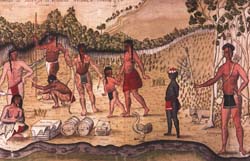
 |
| Drawing of Indians of several nations, New Orleans (colored pen and ink by Alexandre de Batz, 1735) enlarge |
At the dawn of the historic era, when European explorers first entered the land we now call the State of Illinois, they encountered a people who became known to the world as the Illinois or Illiniwek Indians. The Illinois were a populous and powerful nation that occupied a large section of the Mississippi River valley. They became important allies of French fur traders and colonists who came to live among them, and they played a key role in the early history of what would later become the midwestern United States.
The story of the Illinois people is a remarkable tale of adaptation and change. Their world was turned upside down during their long association with French settlers and, later, British and American colonists. As time passed, their population declined and many of their traditional ways of life changed as they adapted to new situations. Eventually the Illinois were forced to leave their traditional lands and move west to Indian Territory. Their descendants, the Peoria Tribe of Indians of Oklahoma, are now scattered throughout the United States but maintain their tribal headquarters in Miami, Oklahoma.
This is the story of the Illinois people when they lived in their traditional homeland, a place the French used to call the "Illinois Country." The story is based, in part, on historical descriptions of the Illinois by French observers like Jacques Marquette and Pierre Delliette, who traveled or lived among them three-hundred years ago. Another part of the story comes from archaeology, as several of the village sites occupied historically by the Illinois people have been excavated by archaeologists. Information also comes from the descendants of the Illinois themselves, who have shared some of their traditional folk tales and have compiled photographs and other documents relating to their history.
Many of the images presented here - including historical maps, paintings, and artifact photographs - are also part of the evidence used to develop the story. For example, the image at the top of this page was painted at New Orleans in 1735 by a French artist named Alexandre de Batz. In his drawing, which shows six Illinois Indians (standing or squatting, upper left), de Batz created one of the earliest known depictions of Illinois clothing, hair styles, body decoration, and weaponry.![]()
This component of the module is divided into nine broad sections that tell different aspects of the story of the Illinois Indians. Each section is subdivided into two or more subsections that focus on specific topics.
- Identity. Answers the question "who were the Illinois Indians?" Identifies the tribes of the Illinois and describes their language, territory, and personal appearance.
- Economy. Answers the question "how did they make a living?" Describes their foods, settlements, trade, and division of labor between men and women.
- Technology. Answers the question "what did their houses look like and what kind of things did they have?" Describes their houses, tools, utensils, containers, weapons, modes of transportation, and objects they obtained from European traders.
- Society. Answers the question "how did they interact with one another and who were their neighbors?" Describes their families, leaders, warfare, social status, forms of recreation, and their Native American and European neighbors.
- Beliefs. Answers the question "what did they believe in?" Describes their ideas about religion, calumet symbolism, health, and death. A subsection on folklore presents four Illinois folk tales.
- Art and Music. Answers the question "what kind of artwork, songs, and musical instruments did they have?" Describes their wood carvings, hide paintings, and music. Includes a recording of a song performed for French explorers in 1673.
- History. Answers the question "what happened to the Illinois Indians when Europeans arrived and where are they today?" Describes the history of the Illinois Indians from their first contact with Europeans to their tragic population decline. Also introduces the living descendants of the Illinois.
- Archaeology. Answers the question "where are the villages of the Illinois Indians and what can we learn fromthem?" Describes efforts to locate and excavate Illinois villages in Illinois. Includes descriptions of four excavated village sites and a discussion of the ancestors of the Illinois Indians.
- How Do We Know? Answers the question "how do we know the story of the Illinois Indians?" Describes the use of historical written records and archaeological excavations as sources of information on the Illinois Indians.
|
|
Copyright © 2000 Illinois State Museum